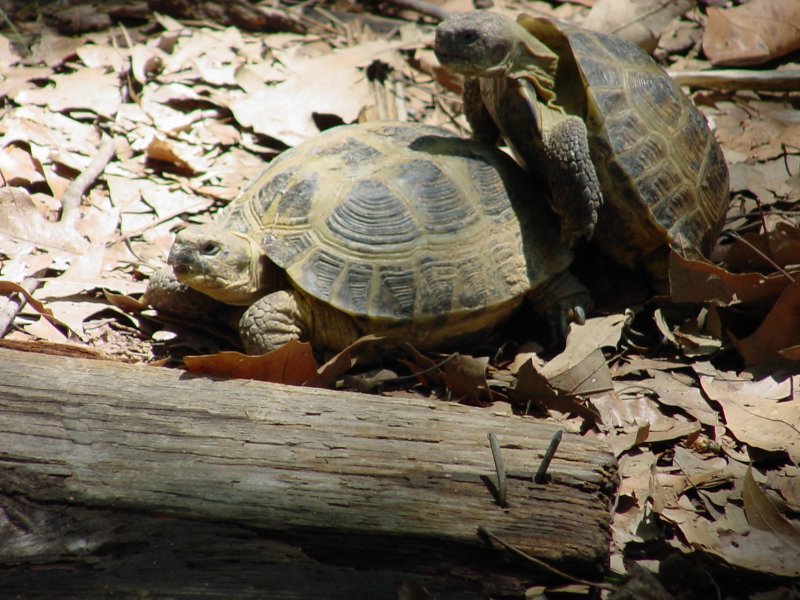

Some breeding activity 2 months after hibernation ended.
Testudo horsfieldi- Russian/Horsfield's tortoise Origin: Asia
My experiences with this species have only just begun after recently receiving a large group of animals in mid-2000. So far, the primary thing that comes to mind in terms of my initial experience is that this species makes the gopher in the movie Caddyshack look like a novice hole digger! Even American box turtles are put to shame by this species (the only one I'm aware of that may rival their digging ability is the Manouria emys) in terms of their rapid creation of burrows. I am now in the process of sinking in a layer of wire mesh about a feet deep around the perimeter of the enclosure in order to keep them in their outdoor enclosure rather than free ranging in my yard.
One of the other primary concerns about keeping this species is that they
do indeed hibernate. I know of at least one individual who has hibernated his
outdoors (he lives in Alabama) but in most areas of the United States, it is probably
necessary to artificially hibernate them in order to achieve good reproductive success as
well as to give them a chance to
"recharge" their batteries. There is also some ongoing discussion over
whether or not there are several subspecies differences which may influence breeding
success.
Dietary preferences for this group seems to be towards dark, green leafy vegetables as well as a number of weeds that grow in their enclosure. A healthy Russian tortoise will eat everything put in front of it.
In terms of personalities, I had always heard that this was an extremely personable species of tortoise. However, biased as I may be, I still think carbonaria (red foots) are the best in this area.
This species is currently being imported into the United States by the tens of thousands out of old Eastern European countries. A number of these individuals are ending up at chain pet stores for anywhere from $39 to $59. Unfortunately, a number of these animals are in very poor shape due to the stress of handling and shipping as well as the mixing of sick animals with healthy ones. If at all possible, purchase captive bred animals- especially of this species. If you do purchase a wild caught horsfieldi, see a veterinarian immediately. At the minimum, the animal will likely have a number of parasites.
Links to further information on T. horsfieldi:
Excellent care article: http://www.chelonia.org/Articles/russiantortoises.htm
Recent information and pictures at the most complete chelonian site on the web: World Chelonian Trust- www.chelonia.org
husbandry/care: http://www.sonic.net/~melissk/russian2.html
husbandry/care: http://www.tortoise.org/archives/russ.html
basics: http://www.reptilemall.com/caresheets/russian2.html
picture: http://www.jps.net/rsw/turtles/horsfiel.gif
pictures: http://www.creativenaturescapes.com/festersworld/animals/turtles/horsfieldi.htm
picture: http://home1.gte.net/mhs2/photos/turtles/horsfld.jpg
![]()